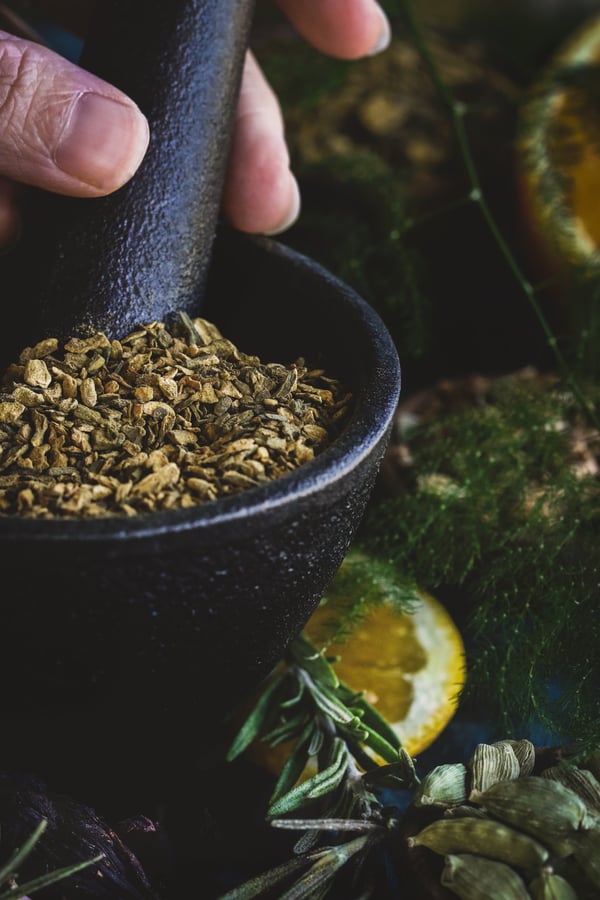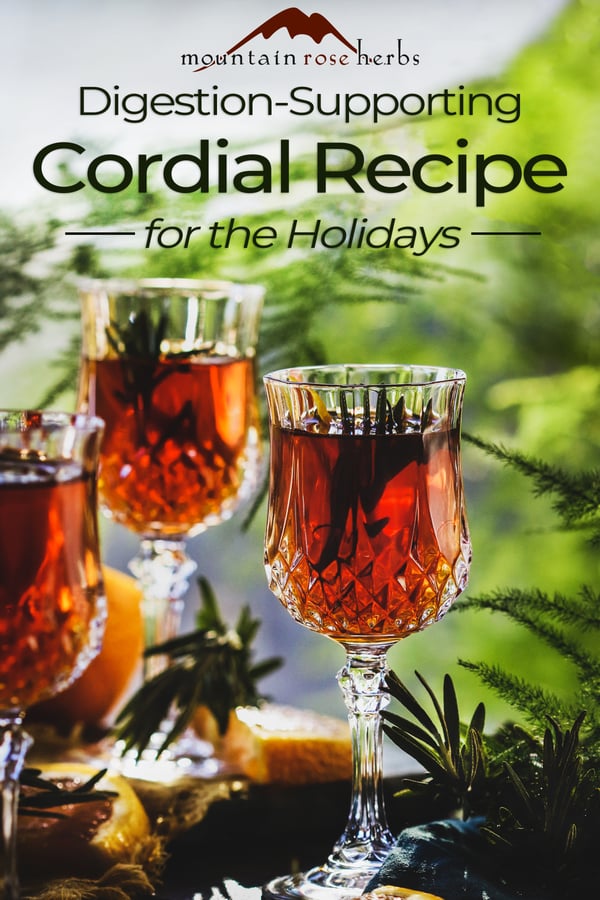In the United States, ‘cordial' and ‘liqueur’ are two words for the same thing; they are sweetened distilled spirits. Although many people know them as cocktail ingredients, cordials can also be potent digestifs. This digestive-aid version of cordials is generally more bitter and less sweet than its cocktail-focused brethren and is loaded with herbs, spices, and other natural flavorings that support the digestive tract. A cordial-digestif can be as simple and delicious as a 3-seed herbal cordial for digestion, or you can make them more complex with layers of herbal flavors and aromas to delight the nose and the palate. Either way, they are ridiculously easy to make. This festive midwinter version with its blend of aromatics and bitters is the perfect finish to a holiday meal, when you have a moment to sit down and enjoy the company of your favorite people.
When I set out to create a midwinter digestif, I had cold weather and winter festivities in mind, so I wanted something warming, something with citrus and an herbaceous base that would round out a big meal and help the gut efficiently process all that hearty food. A cordial was the obvious answer. I think a good roadmap for building an herbal cordial is to start with the bitter herbs and then layer in complimentary or balancing flavors.
Bitter herbs—I chose my group of bitter herbs first, based on their digestive support as well as how well their flavors would blend. I’ve seen a lot of cordial recipes that have only one or two bittering agents and work out very well, but you can certainly add more. I considered other traditional cocktail bitters like wormwood or angelica root, but I wanted to use licorice root and wild cherry bark in this cordial, so decided to compliment those with the earthiness of gentian and roasted dandelion roots. Note here that I was aiming for a digestif, so I wanted a significant bitter action. Now that I had determined what my digestion-supporting bitter herbs would be, I was ready to choose dried herbs to round out the flavor profile.
Dried herbs—I wanted to add depth and a little complexity to the flavor while keeping a wintery theme. Dried herbs allow us to dial in flavors closely, consistently, and affordably. You can be generous in how many you use. I knew I wanted a citrus-forward flavor for this, so I chose dried orange peel first and then built the rest of my dried herb blend around that. In a different circumstance, I might have chosen lemongrass, hyssop, hops flowers, chamomile flowers, star anise, saffron threads, cinnamon, etc. Dried fruit is also an option.
Fresh herbs—The last layer is a touch of fresh aromatics to add a final polish to the herbal blend, but you have to be careful because the fresh botanicals can take over. A little goes a long way. Mints, citrus, rosemary, and sage are fun choices.
The alcohol—I went with a locally distilled brandy in this one, but you could also choose vodka, rum, or another alcohol that is made with natural ingredients. Just note that it should be 40% (80 proof) and have a neutral flavor so your herbal blend gets a chance to shine.
The Sweetener—You can sweeten the cordial all at once so that your cordial is ready whenever you want it for sipping or cocktail making, or you can leave it unsweetened and then sweeten it per cocktail. You can also use straight honey if you don’t want to make a simple syrup, but use an amber honey with a mild flavor and add it slowly so it doesn’t take over your blend.
Midwinter Digestif Cordial Recipe
Makes about 2 cups of cordial.
*Gently smash your dried herbs in a mortar and pestle or spice grinder to create more surface area to infuse into the alcohol, but don’t turn them into powder. Measure the herbs after crushing them.
Ingredients
Bitter Herbs
-
- 1/4-1/2 tsp. crushed organic gentian root
- 1/4-1/2 tsp. crushed organic roasted dandelion root
- 1/4-1/2 tsp. crushed organic licorice root
- 1/4-1/2 tsp. crushed organic wild cherry bark
Dried Herbs
-
- 1 tsp. organic orange peel
- 1 tsp. crushed organic green cardamom pods
- 1 tsp. crushed organic hibiscus flowers
- 1 tsp. organic elderflowers
- 1 tsp. crushed organic turkey rhubarb root
Alcohol
-
- 2 cups 40% (80 proof) neutral spirits—I enjoy vodka and brandy.
Fresh Herbs
-
- 1 large sprig fresh organic rosemary
- 3-4 strips organic orange peel with no pith
Simple Syrup
-
- 1 cup water
- 1 cup organic sweetener of choice: organic sugar, Demerara sugar, honey, maple syrup, etc.
- Combine all the bitter and dried herbs in a quart size jar with an airtight lid.
- Pour the neutral spirits over the herbs and swirl to combine.
- Break the rosemary sprig into 2-3 pieces and add to jar.
- Use a vegetable peeler to make 3-4 strips of orange peel. Add to jar.
- Cap jar and shake to combine.
- Label jar with ingredients and date made.
- Store in a dark, cool place for 4-6 weeks and shake often. Flavor will improve significantly at the 5-week mark.
- When ready to strain, make simple syrup: Combine water and sweetener of choice in a saucepan over medium heat. Stir until sweetener dissolves. Set aside to cool completely. If making ahead, simple syrup will keep, refrigerated, for about one month.
- When simple syrup is cool, strain herbs from alcohol.
- Add simple syrup to strained alcohol a little at a time and taste-test along the way until you reach desired sweetness. I stopped at the 12 Tbsp. mark.
- Store in sterilized glass jars or bottles. Cordial is shelf stable for up to one year.
- This cordial may be sipped as-is or used as a delicious bitter in cocktails.
Pro Tip: I used 1/2 tsp. of each of the bitter herbs to make a digestif-style cordial, but you can absolutely half that amount and go with 1/4 tsp. for a little less bitter. This is a good choice if you plan to share the cordial with people who might not appreciate quite so much bitter.
Want another herbal cordial recipe?
Try This 3-Seed Herbal Cordial Recipe for Digestion
You may also enjoy:
- What are Bitters & How They Work
- Best Herbs for Digestion
- Dandelion and Cacao Bitters for Digestion or Cocktails














